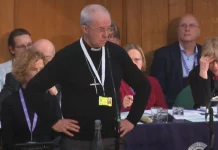SINCE writing my previous piece in TCW critiquing the Church of England’s plan for blessing same-sex couples, the scheme has been enfleshed in the form of the draft Prayers of Love and Faith (PLF). I should couch any criticism here with an understanding that these prayers are still being formulated and should therefore be judged less harshly; however their authors are obviously satisfied enough with their quality to publish them in provisional format on the C of E’s official website. You will not be surprised to learn, reader, that I have one or two issues which I briefly expound here.
The first is the poor theology. Part of the problem is that the PLF have emerged from a theological context which values superficial church ‘unity’ and does not wish to disturb the conscience of the secular world. PLF dishonestly gerrymander doctrine in an attempt to appease the Bible-believing camp by suggesting that these prayers are not a change of doctrine, merely a pastoral provision. The clergy who are propagating PLF are largely insistent that this is not a change of traditional Christian doctrine, and that the Church of England’s official position that marriage is a lifelong union ‘between one man and one woman’ remains unaltered. The church unity the hierarchs are seeking to uphold is nothing more than a common religious history and heritage; they are unconcerned about the doctrinal fidelity to Christ which has always defined church unity (1 Cor. 1:10) and simply seek to maintain an illusory paper unity which has no substantial basis in doctrine, practice or ethics.
As their contradiction belies, the simple reality is that there is a shift in official doctrine here. Like many other churches, Anglicanism determines doctrine in part through the principle of lex orandi, lex credendi (‘the law of prayer [is] the law of faith’ or more helpfully ‘what we pray is what we believe’). That is to say that liturgy serves as a reflection and consolidation of theological beliefs and expresses the faith in a tangible, active way. With this principle in mind, how PLF prayers such as that below can be interpreted as anything other than de facto wedding prayers is beyond me:
‘Dear friends in Christ, we gather with N and N to celebrate with them their love, faithfulness, and commitment. We come to . . . surround N and N with our love and prayer as they seek the blessings of God’s kingdom in their life together . . . enfold your servants N and N with your encouragement, hope, and love. Fill them with the grace to rejoice always in their love for one another, and to follow the Way of holiness and hope revealed in your Son Jesus Christ.’ (PLF, pp.6-7)
Despite prayers like these providing clear evidence of a definitive dogmatic shift, the C of E’s official doctrinal position regarding marriage is ostensibly unchanged and the formal theology of PLF is left deliberately vague and subjective to provide plausible deniability that there has been any change in belief around marriage, when in reality there has.
Read it all in The Conservative Woman










